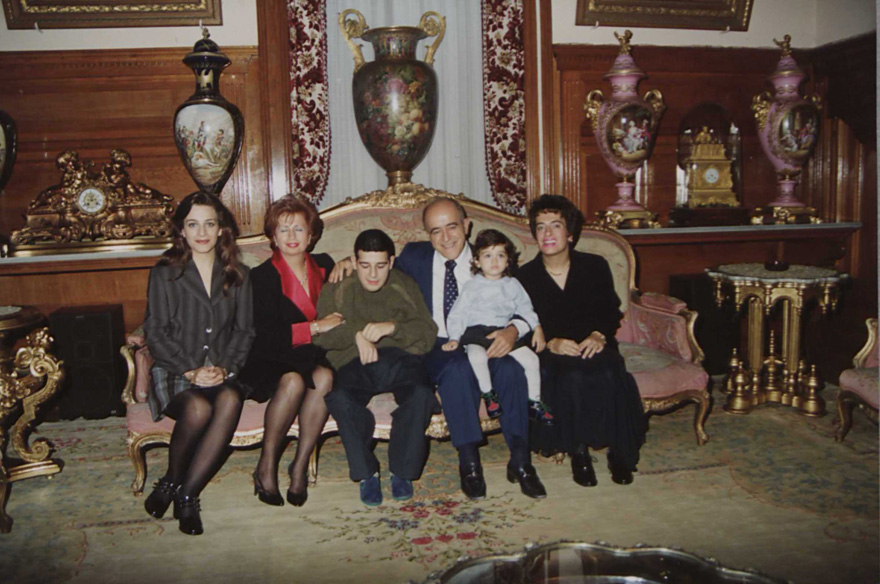LIFE
Sakip Sabanci was born on the 7th of April 1933, in the Akcakaya village of Kayseri in Turkey. He was the second of six children of Haci Omer Sabanci and Sadika Sabanci.
In 1921 the Sabanci Family moved to the city of Adana, called ‘the Tower of Babel’ by Sadun Tanju, due to the many ethnic and religious communities such as Arabs, Tunisians, Bulgarians, Kurds, and Jews. His father Haci Omer’s skills as a cotton trader enabled the family to live in a three room, earthroofed Adana house. Sakip Sabanci lived in this house along with his parents and grandparents, his brothers Ihsan, Haci, Sevket, Erol, and Ozdemir as well as the family housekeeper Gulnaz until 1942 when the family moved into the house known as the “Pink House” or the “Lion House” on the very same street. In his book This is My Life, Sakip Sabanci describes the busy life in about this mud-brick house, so busy that most mornings its inhabitants would leave the house for work or school in haste without breakfast. After finishing Ismet Inonu Primary School in 1944, Sakip Sabanci continued his education until middle school, at Ikinci Orta Okul. He left Adana Boy’s High School because of a pneumonia that continued for three years. This was also the reason for his early entry into the work force.
In 1957, at 24 years of age, Sakip Sabanci married his cousin Turkan Civelek with a wedding in the garden of his aunt`s Bossa Factory. Their happy union lasted for 47 years and was blessed with the birth of Dilek in 1964, Metin in 1970, and Sevil in 1973. In interviews, Mrs. Sabanci describes Sakip as the boss of bothhis business and home, a man who was very hard working but also put great importance on his family: “He would call me ‘Turko’ or ‘Turkos’. I would call him ‘boss’, because he was the boss of both his business and home. He liked me to meet him at the door when he was back from work every day. If I happened to not answer the door one day he would ask “Is Turkan not here?” (13.12.2013) For a man for whom family was the most valuable thing in life, Sakip Sabanci’s biggest losses were the deaths of his father Haci Omer in 1966, his mother Sadika in 1979, the assassination of his brother Ozdemir at Sabanci Center in 1998, and his brother Haci `s loss of his battle with lung cancer in 1998. Sakip Sabanci, who passed away at 71, was a man of great achievements.
As early as 1974 he had the foresight to move the center of the Sabanci Company to Istanbul, with the encouragement of the former President of Turkey, Turgut Ozal, who at the time was General Coordinator of the Company. Sakip Sabanci served as President of Sabanci Holding from 1967-2004. During this period, Sakip Sabanci introduced the Sabanci logo to the world through joint ventures with multinationals such as Bridgestone, DuPont, Toyota, Philip Morris, Kraft Foods International, Danone, IBM, and Carrefour–all of worldwide renown. Starting in 1964, he was a member and President of the Chamber of Industry and Union of Turkish Industry and Trade in Adana and Kocaeli for 25 years. He undertook several roles in various foundations. He chaired the Turkish Industrialists and Businessmen in 1986 and served as President of the High Advisory Board from 1987-1990. Sakip Sabanci has been awarded 15 honarary doctorates from various universities, was chosen business person of the year in 1993 and 2001. In addition to the orders and awards from the governments of Japan, Belgium, and France for improving Turkey`s relationships with these countries, he also received the “Meritorious Service Medal” and “Culture and Art Grand Award” for his services in art, education and culture. When Sakip Sabanci passed away in 2004, he ranked 147the in Forbes’ list of billionaires.
Sakip Sabanci, known as such a colorful and energetic character that the public nicknamed him, “Sakip Agha,” fit a good many successes in his 71 years. He had his first cardiac valve surgery in 1981; the second, in 1989 in Houston. He passed away on the 10th of April, 2004 at 17:55 in the American Hospital from pneumonia. On the 12th of April 2004, he was burried in Zincirlikuyu Cemetery after a state ceremony in Sabanci Center and a funeral with an attendance of approximately 100,000.
